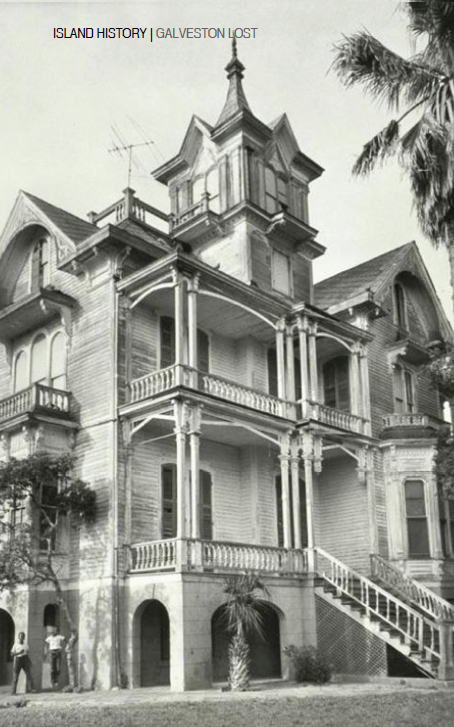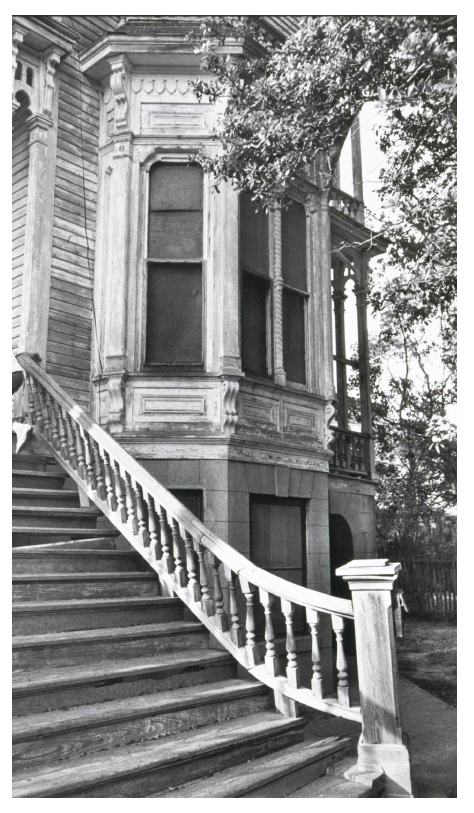 A grand residence once graced the northeast corner of 16th Street and Broadway, home to a succession of families who left an impact on Galveston Island that lasted long after their beautiful home was lost.
A grand residence once graced the northeast corner of 16th Street and Broadway, home to a succession of families who left an impact on Galveston Island that lasted long after their beautiful home was lost.
It was built in 1876 by Captain Jeremiah Niles Sawyer (1829-1899), who was a native of Connecticut. After beginning his career as an apprentice on a whaling ship, Sawyer soon became a mate and then captain of a series of ships. He commanded a number of vessels around the world to places such as Alaska, Cape Horn, San Francisco, Honolulu, Europe, and the West Indies.
In 1850, Sawyer married Mary Emma (1829-1874), the daughter of a fellow sea captain. Her familiarity with the demands of her husband’s career was helpful during his many long absences. Sawyer was put in charge of a steamer for the United States government in the early 1860s and continued in that position until the end of the Civil War.
He joined the New York and Texas Steamship Company (which became the Malloy Line) in 1867 and moved to Galveston in 1871. By that time, he and Mary had two young daughters: Emeline “Lina” Olive (1861-1936) and Phoebe Eldridge (1870-1947). The family initially lived in an apartment above the business on the Strand.
Mary passed away in 1874, leaving the captain with two youngsters in his care. He took her body home to Connecticut for burial but returned to his duties in Galveston.
In addition to his business obligations, Sawyer found time to be involved with social and community activities including the Mardi Gras celebrations of 1875 when he was a member of the Knights of Myth. He also took part in settling the Longshoreman’s Strike of 1885.
In 1876, Sawyer recognized the need for a home that would accommodate the social demands of his and his daughters’ lifestyles. The first floor of the new Sawyer residence featured soaring 13-foot ceilings.
 An elegant dining room, two halls, double parlor, and library were constructed with hardwood floors, plastered and painted walls, and plaster cornices. The kitchen, outfitted with a butler’s pantry and dumbwaiter, had pine flooring and windows equally as large as the front of the home.
An elegant dining room, two halls, double parlor, and library were constructed with hardwood floors, plastered and painted walls, and plaster cornices. The kitchen, outfitted with a butler’s pantry and dumbwaiter, had pine flooring and windows equally as large as the front of the home.
Four bedrooms decorated with wallpaper and featuring 12-foot ceilings, a central hall, and six closets populated the second floor. The third floor, referred to as the attic, had a hall leading to a single carpeted bedroom with a 9-foot ceiling.
This presumably would have provided a servant’s quarters. The remainder of the third story was floored with wood to provide storage space.
An impressive fourth floor tower adorned the top of the home. Inside was a carpeted room where the family could enjoy panoramic views and Gulf breezes.
Below it all, a large basement with concrete floors and walls could be accessed beneath the stairs. It was designed with three built-in slate washtubs to provide a place to do laundry.
In all, the home had nine papered rooms, six painted rooms, two baths, nine closets, six fireplaces, and seven porches. It was a spacious residence for a family of three, but the number of family members would soon increase.
In 1878, Sawyer married Francis “Fannie” L. Fish (1841-1906) who was from his hometown of Groton, Connecticut. She had never been married previously, and they most likely knew each other before the captain moved south.
Their wedding was followed by Emeline’s marriage to Hampton Young (1857-1931) the following year and then the marriage of daughter Phoebe in 1890 to Harry Ambrose Griffin (1866-1917), the son of a popular former postmaster. Elaborately decorated receptions for each of the weddings were held in the home on Broadway and attended by large number of friends and business associates.
A small number of livestock and a kitchen garden at the home became an increasing responsibility for the aging owners, as reflected in a humorous (by today’s sensibilities) advertisement that ran in the local newspaper in June 1893. It announced the search for “a sober man who understands milking a cow, caring for a horse, and making himself useful about the premises.”
After working for the shipping line for over 25 years, Sawyer retired from business and passed away in 1899. Having no children of her own, Fannie returned to Groton to live with her niece and opened her large home to renters. Her two stepdaughters remained on the island in their own homes with their young families.
In late August 1905, the home left ownership of the Sawyer family for the first time when the captain’s widow sold the homestead to Mrs. Hannah Delanoy Flood (1857-1948) for $5,000. Interestingly, Hampton Young (Captain Sawyer’s son-in-law) held positions working for both owners of the family home—as a clerk for Sawyer and eventually as a bookkeeper for Flood.
Hannah was the wife of Edwin Orville Flood (1855-1938), a native New Yorker. The couple had moved to Galveston shortly after their marriage in 1883.
A president of the Galveston Chamber of Commerce, Flood operated a wholesale and retail coal business in Galveston for 30 years named E. O. Flood & Company. He also owned the steamship Manteo which was used to transfer cargo from ships to barges and facilitate easy transfer of goods to the harbor.
Hannah supervised improvements and renovations to their new home including repainting the exterior and interior, installing electricity with push button switches in some of the rooms, and placing wooden flooring in the basement to create a large dance floor. After a flurry of contractor activity, the Flood family moved into their home after just 10 days.
The couple’s three children, George Delanoy (1885-1953), Elizabeth Peshine (1884-1968), and Aimee (1889-1964), each had social calendars almost as busy as their parents’, and the home was filled with activity. In good weather, lawn parties were hosted outside with the grounds illuminated by Japanese lanterns and refreshments served on the porch.
A 1907 article in the Galveston Daily News described the Flood residence as “ideal” for entertaining the younger members of the family and their friends. One particular party in the “pleasure rooms” (basement) below the stairs was described as offering progressive games of “Five Hundred” at card tables arranged around the room. Afterward, the tables were cleared off the dance floor and the attendees danced until the early morning hours.
Flood was active in civic life as well, and as vice president of the Galveston Hotel Company, he was instrumental in organizing funding and bringing about the construction of the Hotel Galvez. After its opening in 1911, the Flood family often attended special occasions and dinners at the resort.
The weddings of the Flood offspring provided additional reasons for celebrations in their magnificent home. Elizabeth married Charles Allison Briggs in 1908, and George married Mary Virginia Calvert (1890-1968) in 1913, but the most elaborate wedding celebration held at the Flood mansion was the 1913 marriage of their youngest daughter Aimee to Dr. Henry Reid Robinson (1886-1966), a physician at John Sealy Hospital.
The entire wedding took place at the home which was decorated with garlands, sprays of greenery, pink Killarney, and bride roses for the occasion. The couple exchanged vows in the drawing room, and gifts from well wishers filled the library. An informal reception followed with music provided by Conway R. Shaw’s orchestra, regular performers at Hotel Galvez. The newlyweds’ home at 1121 19th Street still stands.
During World War I, Flood became associated with Texas’ coal administration to help regulate the popular fuel which was in short supply. Immediately after the war, he retired from all commercial and civic activities.
Elizabeth and her husband lived in the Flood home until shortly after 1920 when the couple divorced. Then in the summer of 1935, Robinson’s Dancing Studio opened in the basement of the home and utilized the dance floor that so many Galvestonians had enjoyed for decades. Aimee’s daughter Margaret Edwina Robinson (1919-1977) was the instructor, specializing in ballroom and tap.
Flood passed away in January 1938 in his beloved home at the age of 82, but family gatherings continued in the residence for several years. Even the Flood’s grandchildren made use of the large home for their parties and wedding receptions, like that of George’s son William Calvert Flood (1917-1989) and Beverly Ardis Cronk (1920-2009) in 1944.
When Hannah passed away in 1948, her children sold the home. It had never been fully wired for electricity. Abraham Druss (1904-1960), an immigrant from Russia, purchased the home for $29,000 as part of his real estate portfolio. The owner of Druss Army & Navy Store and a furniture store, Druss owned several properties around the island.
The residence was subdivided into eleven apartments that provided housing for members of the military and their spouses. After Druss’ death in 1960, the home fell into disrepair and was eventually razed in 1965.
The site of this once enviable home is now a public park where visitors can see one of the historic Rosenberg Fountains and reflect on the lost grandeur of the past.